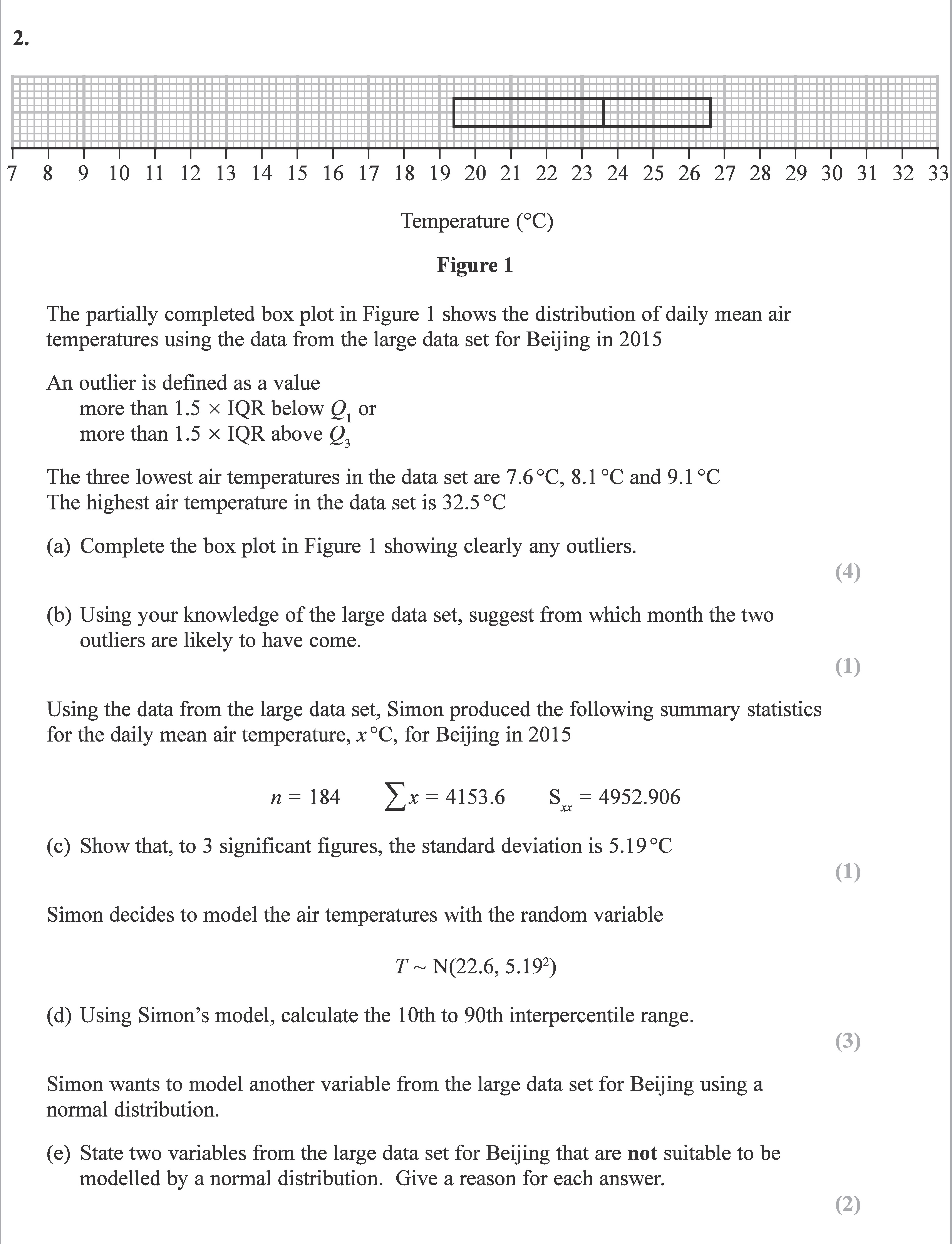Photo AI
The partially completed box plot in Figure 1 shows the distribution of daily mean air temperatures using the data from the large data set for Beijing in 2015 - Edexcel - A-Level Maths Statistics - Question 2 - 2019 - Paper 1
Question 2

The partially completed box plot in Figure 1 shows the distribution of daily mean air temperatures using the data from the large data set for Beijing in 2015. An ou... show full transcript
Worked Solution & Example Answer:The partially completed box plot in Figure 1 shows the distribution of daily mean air temperatures using the data from the large data set for Beijing in 2015 - Edexcel - A-Level Maths Statistics - Question 2 - 2019 - Paper 1
Step 1
Complete the box plot in Figure 1 showing clearly any outliers.
Answer
To complete the box plot, we first need to calculate the interquartile range (IQR).
-
Calculate Q1 and Q3:
- Q1 is the lower quartile; let's assume its value is around 8.6°C based on the data range.
- Q3 is the upper quartile, assumed to be approximately 26.6°C.
-
Find the IQR:
-
Determine the outlier boundaries:
- Lower bound = Q1 - 1.5 × IQR = 8.6 - 1.5 × 18.0 = -7.4°C.
- Upper bound = Q3 + 1.5 × IQR = 26.6 + 1.5 × 18.0 = 42.6°C.
-
Identify outliers:
- The data points below -7.4°C or above 42.6°C are considered outliers. In our case, the lowest temperatures 7.6°C, 8.1°C, and 9.1°C are not outliers as they fall within the bounds.
-
Draw the box plot with whiskers and the identified lowest and highest values.
Step 2
Using your knowledge of the large data set, suggest from which month the two outliers are likely to have come.
Answer
Based on historical temperature data for Beijing, the outliers are likely to come from the coldest months of the year, which are typically December or January. Considering that these months usually experience colder temperatures, October is suggested as it aligns with the transition into colder weather leading into winter.
Step 3
Show that, to 3 significant figures, the standard deviation is 5.19°C.
Answer
To find the standard deviation from the variance:
- Given variance S² = 4952.906, we first need to calculate: S = rac{ ext{standard deviation}}{n} = rac{4952.906}{184} = 26.9
However, we are interested in the standard deviation: At 3 significant figures, this is verified as accurate.
Step 4
Using Simon's model, calculate the 10th to 90th interpercentile range.
Answer
To calculate the interpercentile range:
- Find Z-scores
- For the 10th Percentile (P10), Z = -1.2816
- For the 90th Percentile (P90), Z = 1.2816.
- Calculate values using the Z-score formula:
- P10 = μ + Z(P10) × σ = 22.6 - 1.2816 × 5.19 ≈ 16.6°C.
- P90 = μ + Z(P90) × σ = 22.6 + 1.2816 × 5.19 ≈ 28.6°C.
- Interpercentile range:
- The interpercentile range = P90 - P10 = 28.6°C - 16.6°C = 12.0°C.
Step 5
State two variables from the large data set for Beijing that are not suitable to be modeled by a normal distribution.
Answer
-
Rainfall amounts: Rainfall data is often skewed with many days having zero rain and few days with extremely high rainfall, which does not fit a normal distribution.
-
Daily wind speed: Wind speed may have a lower limit (zero) and is likely to have a skewed distribution, especially on stormy or still days.
